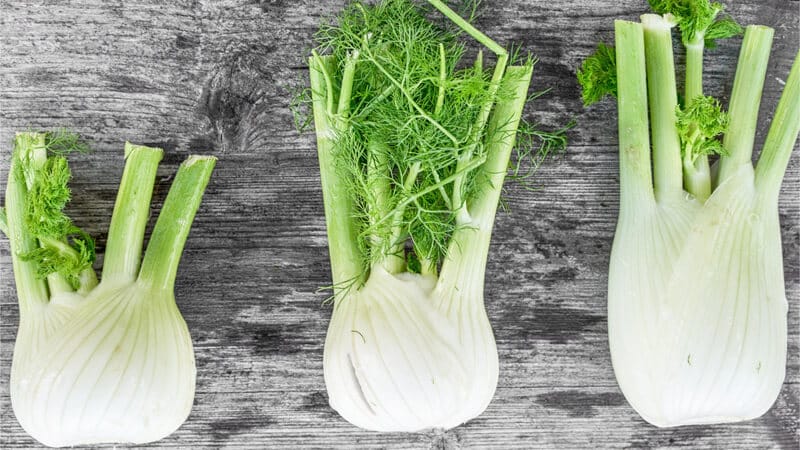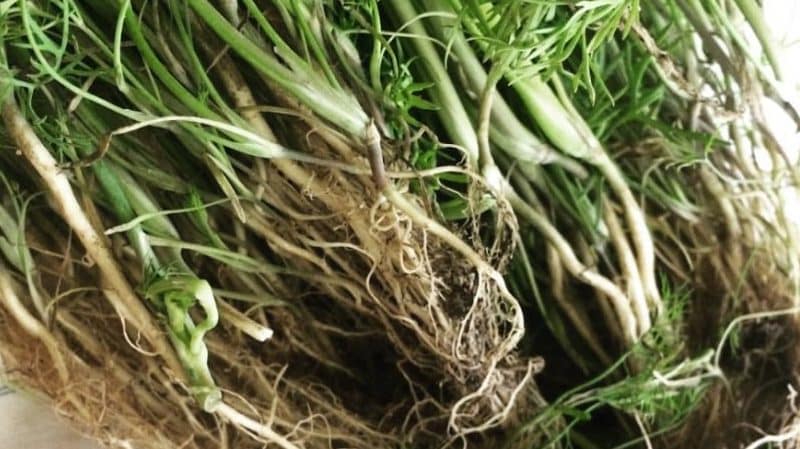Beneficial properties of dill root and its medicinal uses
Dill is added as a spice to a variety of dishes. It is widely used in folk medicine for the treatment and prevention of problems with the digestive, cardiovascular, nervous, and genitourinary systems. The root of this plant, which has a rich nutrient composition, is especially valuable.
Composition and structure of the plant
Dill is an annual plant of the Apiaceae family. The cultivated spice is small fluffy bushes about 25 cm high. The stem of wild dill reaches 1.5 m in length.
Features of culture:
- pinnately dissected leaves resembling threads;
- smooth stem covered with a whitish or bluish coating;
- yellow inflorescences in the form of umbrellas.
Greens and dill root are rich in vitamins:
- Group B;
- retinol;
- tocopherol;
- ascorbic acid;
- beta-carotene;
- nicotinic acid.
Macro- and microelements in the plant that are necessary for the normal functioning of the body:
- calcium;
- magnesium;
- potassium;
- zinc;
- manganese;
- magnesium;
- sodium.
Dill contains a large amount of flavonoids and essential oil, which gives it a specific smell.
Beneficial properties of the root

The beneficial effect of dill root is due to the valuable components included in its composition. Products prepared from the plant have the following therapeutic effects:
- normalize the functioning of the digestive system;
- increase appetite;
- reduce blood pressure;
- strengthen the heart muscle;
- improve blood circulation;
- normalize metabolism.
Dill root helps remove toxins from the body and has a beneficial effect on the functioning of the endocrine glands. It has choleretic and diuretic properties and a general strengthening effect.
For women
The plant is useful women of all ages. It stabilizes the hormonal cycle and is effective in treating inflammation of the genitourinary system.
Important! In pregnant women, the root improves the functioning of the gastrointestinal tract, relieves symptoms of toxicosis and swelling, and normalizes sleep.
The plant stimulates milk production when breastfeeding, replenishes the lack of vitamins and minerals during gestation and lactation.
For men
Compositions with dill root are used to prevent genitourinary diseases in men, and also as an effective potency stimulant. Such effects of the plant are explained by its vasodilating properties and general strengthening effect.
For children
The root is widely used to treat children of all ages. Dill water is a proven and effective remedy against abdominal colic in infants. The plant promotes the release of gases and relieves painful spasms, normalizes the functioning of the child’s digestive system.
It is used for cystitis to eliminate inflammation of the bladder.
Use in folk medicine

Dill is widely used in folk medicine to treat a number of diseases, eliminating extra pounds and improving skin condition.
Attention! It is recommended to take dill preparations only after consultation with a specialist. Diseases and ailments require professional and complex therapy - dill should be used exclusively as an additional, but not the main means of treatment.
For hypertension
Decoctions, infusions and teas are made from the root.The active biological substances in its composition have a beneficial effect on the condition of the heart and dilate blood vessels. As a result, blood pressure decreases.
A pronounced effect is obtained by the composition prepared according to this recipe:
- 2 tbsp. l. The roots are crushed and poured with 200 ml of boiling water.
- Keep in a closed container in a water bath for about 15 minutes.
- After cooling, filter.
Take the medication 50 ml 3 times a day, 20–30 minutes before meals.
For kidneys and liver
The diuretic, choleretic and antibacterial properties of the root eliminate the symptoms of a number of diseases of these organs. For the treatment of kidneys, the same composition is used as for hypertension. Drink it 50 ml 6 times a day.
The root is useful for liver inflammation:
- 1 tbsp. l. chopped root pour 1 tbsp. water and bring to a boil.
- Keep on low heat for about 10 minutes.
- Cool and filter.
Take 1/2 tbsp. three times a day, regardless of meals.
For colds
For coughing attacks and colds, a decoction of the plant has a good effect. The washed and ground root (1 tbsp) is placed in an enamel pan and 250 ml of boiling water is poured. The product is placed on low heat for a quarter of an hour. After cooling, drink 100 ml three times a day, before meals.
For the nervous system
The herbal infusion will calm the nervous system during stress and increased nervous load, and improve sleep. To prepare it, 2 tbsp. l. raw materials pour 1 tbsp. boiling water, simmer in a water bath for 10–15 minutes. Drink chilled 25 ml 3 times a day, 20 minutes before meals.
For injuries and wounds
An ointment with antiseptic properties is prepared from the root. To do this, the plant is ground to a powder and mixed with pork fat in a 3:1 ratio.
For eye inflammation
Lotions with a decoction of dill root eliminate the symptoms of conjunctivitis. To prepare them, 1-2 tbsp. l. raw materials are poured with hot water and boiled over low heat for about 10 minutes. The product is cooled and filtered. Gauze swabs are moistened with the solution and applied to the affected eyes. Keep for about 15 minutes.
For digestion
The plant eliminates increased gas formation and normalizes digestion. The infusion is prepared according to the following scheme:
- 1 tbsp. l. roots are crushed and poured 1 tbsp. boiling water
- Place in a water bath for 15 minutes.
- Cool to room temperature and filter.
Drink 70–80 ml 40–50 minutes before meals.
For beauty
The healing components contained in the root have a positive effect on the condition of the skin, hair and nails.
Important! A decoction of the plant gives a lasting effect in the treatment of acne: it has antibacterial and tonic effects.
Wash with the product and use it in the form frozen ice cubes for wiping the skin. This facial treatment reduces inflammation, reduces pores and eliminates fine wrinkles.
For problem and oily skin, the broth is mixed with sour cream. The mask promotes:
- cleansing pores;
- their narrowing;
- eliminating the infection.
The concentrated product is mixed with sour cream in a 2:1 ratio, 2-3 drops of jasmine oil are added. The mask is applied to well-cleansed facial skin for 15–20 minutes, rinsed off with warm water.
For weight loss
Dill is introduced into the diet during a diet. It improves intestinal function and speeds up metabolism, removes excess fluid and harmful substances.
When losing weight decoctions, infusions and teas are used. This recipe is popular:
- The roots are thoroughly crushed.
- The resulting mixture (3 tablespoons) is placed in an enamel bowl and 0.5 liters of boiling water is added.
- Allow the mixture to boil and keep on low heat for 3-5 minutes.
Drink 100 ml before meals.
Possible harm and contraindications

Dill root remedies have contraindications. The plant will have to be excluded from the diet for people suffering from the following pathological conditions:
- tendency to low blood pressure;
- inflammation of the pancreas;
- deficiency of individual blood components: due to the diuretic effect of dill, beneficial substances are also removed from the body.
It is recommended to use the root with caution for those who have vision problems: the vasodilating effect of the plant can cause negative changes in the visual system.
Attention! During pregnancy, medicinal formulations based on dill are not used so as not to cause uterine hypertonicity.
Conclusion
Dill is a useful plant, the root and leaves of which help to cope with problems with the digestive, genitourinary, and cardiovascular systems. Although the herbal remedy is harmless to the body and is used to treat even small children, it is used with caution, following the recommended standards and advice from specialists.